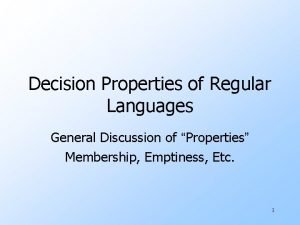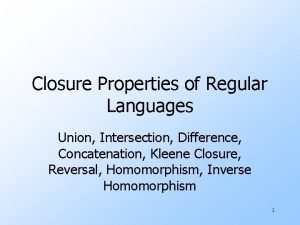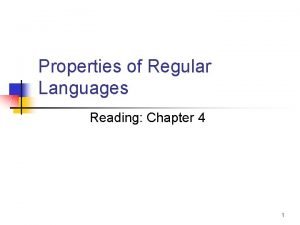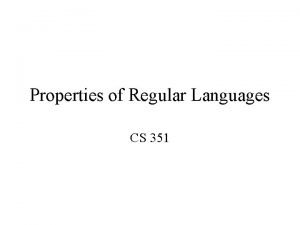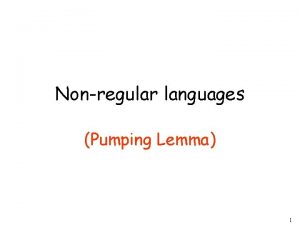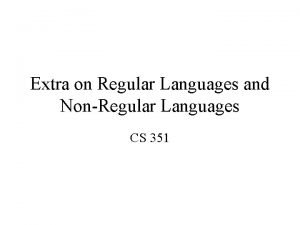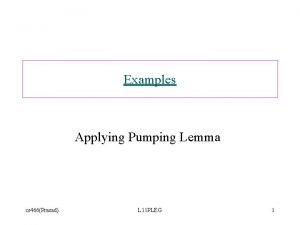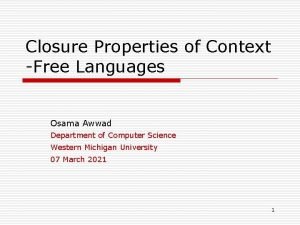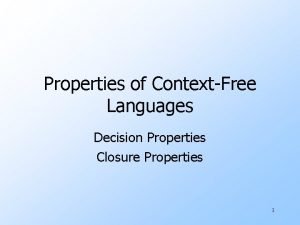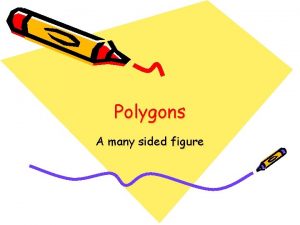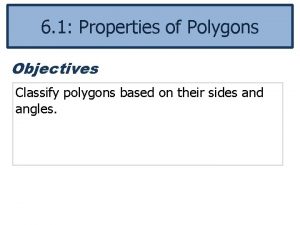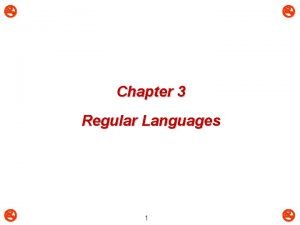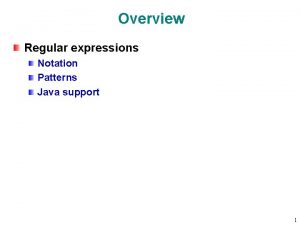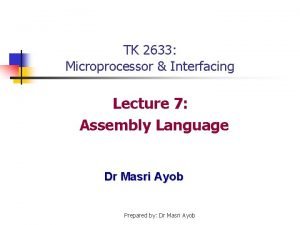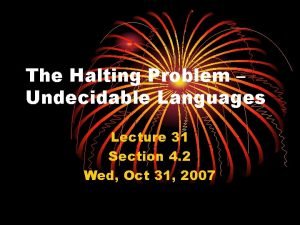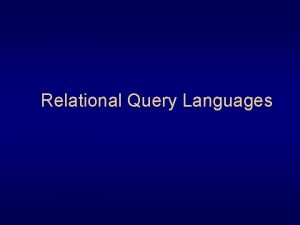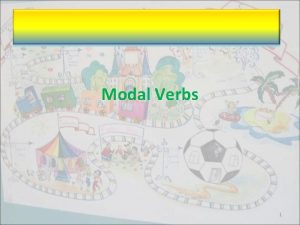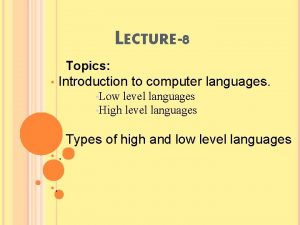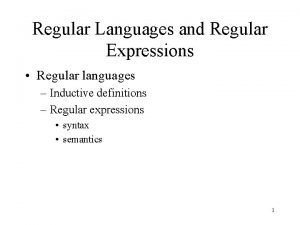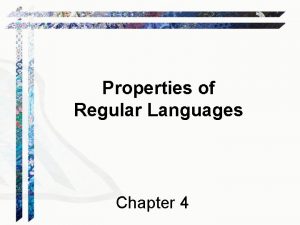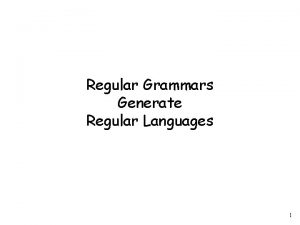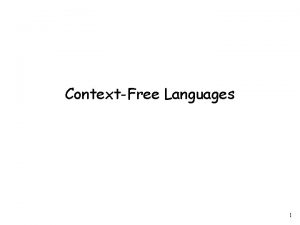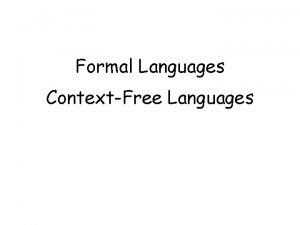Properties of Regular Languages Reading Chapter 4 1


























































- Slides: 58

Properties of Regular Languages Reading: Chapter 4 1

Topics 1) 2) 3) How to prove whether a given language is regular or not? Closure properties of regular languages Minimization of DFAs 2

Some languages are not regular When is a language is regular? if we are able to construct one of the following: DFA or NFA or -NFA or regular expression When is it not? If we can show that no FA can be built for a language 3

How to prove languages are not regular? What if we cannot come up with any FA? A) Can it be language that is not regular? B) Or is it that we tried wrong approaches? How do we decisively prove that a language is not regular? “The hardest thing of all is to find a black cat in a dark room, especially if there is no cat!” -Confucius 4

Example of a non-regular language Let L = {w | w is of the form 0 n 1 n , for all n≥ 0} n Hypothesis: L is not regular n Intuitive rationale: How do you keep track of a running count in an FA? n A more formal rationale: Ø Ø By contradition, if L is regular then there should exist a DFA for L. Let k = number of states in that DFA. Consider the special word w= 0 k 1 k => w L DFA is in some state pi, after consuming the first i symbols in w 5

Uses Pigeon Hole Principle Rationale… Ø Ø Ø Let {p 0, p 1, … pk} be the sequence of states that the DFA should have visited after consuming the first k symbols in w which is 0 k But there are only k states in the DFA! ==> at least one state should repeat somewhere along the path (by ++ Principle) ==> Let the repeating state be pi=p. J for i < j ==> We can fool the DFA by inputing 0(k-(j-i))1 k and still get it to accept (note: k-(j-i) is at most k-1). ==> DFA accepts strings w/ unequal number of 0 s and 1 s, implying that the DFA is wrong! 6

The Pumping Lemma for Regular Languages What it is? The Pumping Lemma is a property of all regular languages. How is it used? A technique that is used to show that a given language is not regular 7

Pumping Lemma for Regular Languages Let L be a regular language Then there exists some constant N such that for every string w L s. t. |w|≥N, there exists a way to break w into three parts, w=xyz, such that: 1. 2. 3. y≠ |xy|≤N For all k≥ 0, all strings of the form xykz L This property should hold for all regular languages. Definition: N is called the “Pumping Lemma Constant” 8

Pumping Lemma: Proof n n n L is regular => it should have a DFA. n Set N : = number of states in the DFA Any string w L, s. t. |w|≥N, should have the form: w=a 1 a 2…am, where m≥N Let the states traversed after reading the first N symbols be: {p 0, p 1, … p. N} Ø Ø ==> There are N+1 p-states, while there are only N DFA states ==> at least one state has to repeat i. e, pi= p. Jwhere 0≤i<j≤N (by PHP) 9

Pumping Lemma: Proof… Ø => We should be able to break w=xyz as follows: Ø Ø Ø Now consider another string wk=xykz , where k≥ 0 Case k=0 Ø Ø p 0 x (for k loops) pi =pj z pm DFA will reach the accept state pm Case k>0 Ø Ø x=a 1 a 2. . ai; y=ai+1 ai+2. . a. J; z=a. J+1 a. J+2. . am x’s path will be p 0. . pi y’s path will be pi pi+1. . p. J (but pi=p. J implying a loop) z’s path will be p. J+1. . pm yk DFA will loop for yk, and finally reach the accept state pm for z In either case, wk L This proves part (3) of the lemma 10

Pumping Lemma: Proof… For part (1): n n Since i<j, y ≠ p 0 x yk (for k loops) z pi pm =pj For part (2): n n n By PHP, the repetition of states has to occur within the first N symbols in w ==> |xy|≤N 11

The Purpose of the Pumping Lemma for RL n To prove that some languages cannot be regular. 12

How to use the pumping lemma? Think of playing a 2 person game n n Role 1: be regular We claim that the language cannot Role 2: An adversary who claims the language is regular We show that the adversary’s statement will lead to a contradiction that implyies pumping lemma cannot hold for the language. We win!! 13

How to use the pumping lemma? (The Steps) (we) L is not regular. (adv. ) Claims that L is regular and gives you a value for N as its P/L constant (we) Using N, choose a string w L s. t. , 1. 2. 3. 1. 2. |w| ≥ N, Using w as the template, construct other words wk of the form xykz and show that at least one such wk L => this implies we have successfully broken the pumping lemma for the language, and hence that the adversary is wrong. (Note: In this process, we may have to try many values of k, starting with k=0, and then 2, 3, . . so on, until wk L ) 14

Note: We don’t have any control over N, except that it is positive. We also don’t have any control over how to split w=xyz, but xyz should respect the P/L conditions (1) and (2). Using the Pumping Lemma n What WE do? 3. Using N, we construct our template string w 4. Demonstrate to the adversary, either through pumping up or down on w, that some string wk L (this should happen regardless of w=xyz) n What the Adversary does? 1. Claims L is regular 2. Provides N 15

Note: This N can be anything (need not necessarily be the #states in the DFA. It’s the adversary’s choice. ) Example of using the Pumping Lemma to prove that a language is not regular Let Leq = {w | w is a binary string with equal number of 1 s and 0 s} n Your Claim: Leq is not regular n Proof: Ø Ø By contradiction, let Leq be regular P/L constant should exist Ø Ø Ø 3) adv. Let N = that P/L constant Consider input w = 0 N 1 N (your choice for the template string) By pumping lemma, we should be able to break w=xyz, such that: 1) y≠ 2) adv. |xy|≤N For all k≥ 0, the string xykz is also in L you 16

Template string w = 0 N 1 N = 00 …. N 011 … N 1 Proof… Ø Ø Setting k=0 is Ø referred to as “pumping down” Ø Ø Setting k>1 is referred to as “pumping up” you Because |xy|≤N, xy should contain only 0 s Ø (This and because y≠ , implies y=0+) Therefore x can contain at most N-1 0 s Also, all the N 1 s must be inside z By (3), any string of the form xykz Leq for all k≥ 0 Case k=0: xz has at most N-1 0 s but has N 1 s Therefore, xy 0 z Leq This violates the P/L (a contradiction) Another way of proving this will be to show that if the #0 s is arbitrarily pumped up (e. g. , k=2), then the #0 s will become exceed the #1 s 17

Exercise 2 Prove L = {0 n 10 n | n≥ 1} is not regular Note: This not to be confused with the pumping lemma constant N. That can be different. In other words, the above question is same as proving: m m n L = {0 10 | m≥ 1} is not regular 18

Example 3: Pumping Lemma Claim: L = { 0 i | i is a perfect square} is not regular n Proof: Ø Ø Ø Ø By contradiction, let L be regular. P/L should apply Let N = P/L constant Choose w=0 N 2 By pumping lemma, w=xyz satisfying all three rules By rules (1) & (2), y has between 1 and N 0 s By rule (3), any string of the form xykz is also in L for all k≥ 0 Case k=0: Ø Ø Ø #zeros (xy 0 z) = #zeros (xyz) - #zeros (y) 2 N – N ≤ #zeros (xy 0 z) ≤ N 2 - 1 (N-1)2 < N 2 - N ≤ #zeros (xy 0 z) ≤ N 2 - 1 < N 2 xy 0 z L But the above will complete the proof ONLY IF N>1. … (proof contd. . Next slide) 19

Example 3: Pumping Lemma Ø (proof contd…) Ø Ø If the adversary pick N=1, then (N-1)2 ≤ N 2 – N, and therefore the #zeros(xy 0 z) could end up being a perfect square! This means that pumping down (i. e. , setting k=0) is not giving us the proof! So lets try pumping up next… Case k=2: Ø Ø Ø #zeros (xy 2 z) = #zeros (xyz) + #zeros (y) N 2 + 1 ≤ #zeros (xy 2 z) ≤ N 2 + N N 2 < N 2 + 1 ≤ #zeros (xy 2 z) ≤ N 2 + N < (N+1)2 xy 2 z L (Notice that the above should hold for all possible N values of N>0. Therefore, this completes the proof. ) 20

Closure properties of Regular Languages 21

Closure properties for Regular Languages (RL) This is different n Closure property: n n from Kleene closure If a set of regular languages are combined using an operator, then the resulting language is also regular Regular languages are closed under: n n n Union, intersection, complement, difference Reversal Kleene closure Now, lets prove all of this! Concatenation Homomorphism Inverse homomorphism 22

RLs are closed under union n IF L and M are two RLs THEN: Ø Ø Ø they both have two corresponding regular expressions, R and S respectively (L U M) can be represented using the regular expression R+S Therefore, (L U M) is also regular How can this be proved using FAs? 23

RLs are closed under complementation n Ø If L is an RL over ∑, then L=∑*-L To show L is also regular, make the following construction Convert every final state into non-final, and every non-final state into a final state DFA for L q 0 q. F 1 qi q. F 2 … … q. Fk Assumes q 0 is a non-final state. If not, do the opposite. 24

RLs are closed under intersection n A quick, indirect way to prove: n n By De. Morgan’s law: L ∩ M = (L U M) Since we know RLs are closed under union and complementation, they are also closed under intersection A more direct way would be construct a finite automaton for L ∩ M 25

DFA construction for L ∩ M n n n AL = DFA for L = {QL, ∑ , q. L, FL, δL } AM = DFA for M = {QM, ∑ , q. M, FM, δM } Build AL ∩ M = {QLx QM, ∑, (q. L, q. M), FLx FM, δ} such that: n n δ((p, q), a) = (δL(p, a), δM(q, a)), where p in QL, and q in QM This construction ensures that a string w will be accepted if and only if w reaches an accepting state in both input DFAs. 26

DFA construction for L ∩ M DFA for L q 0 DFA for M q. F 1 qi a qj q. F 2 p 0 p. F 1 pi a pj p. F 2 … … DFA for L M (q. F 1 , p. F 1) a (qj , pj) … (q 0 , p 0) (qi , pi) 27

RLs are closed under set difference n We observe: n n L-M=L∩M Closed under intersection Closed under complementation Therefore, L - M is also regular 28

RLs are closed under reversal Reversal of a string w is denoted by w. R n E. g. , w=00111, w. R=11100 Reversal of a language: n LR = The language generated by reversing all strings in L Theorem: If L is regular then LR is also regular 29

-NFA Construction for R L New -NFA for LR DFA for L Make the old start state as the only new final state What to do if q 0 was one of the final states in the input DFA? qi a qj q. F 2 … q 0 q. F 1 q’ 0 New start state q. Fk Reverse all transitions Convert the old set of final states 30 into non-final states

If L is regular, LR is regular (proof using regular expressions) Let E be a regular expression for L Given E, how to build ER? Basis: If E= , Ø, or a, then ER=E Induction: Every part of E (refer to the part as “F”) can be in only one of the three following forms: n n 1. 2. 3. F = F 1+F 2 n FR = F 1 R+F 2 R F = F 1 F 2 n F R = F 2 RF 1 R F = (F 1)* n (FR)* = (F 1 R)* 31

Homomorphisms n Substitute each symbol in ∑ (main alphabet) by a corresponding string in T (another alphabet) n n h: ∑--->T* Example: n n Let ∑={0, 1} and T={a, b} Let a homomorphic function h on ∑ be: n n n h(0)=ab, h(1)= If w=10110, then h(w) = ab ab = abab In general, n h(w) = h(a 1) h(a 2)… h(an) 32

Given a DFA for L, how to convert it into an FA for h(L)? FA Construction for h(L) DFA for L q 0 q. F 1 qi a q. F 2 … h(a) qj Replace every edge “a” by a path labeled h(a) in the new DFA q. Fk - Build a new FA that simulates h(a) for every symbol a transition in the above DFA - The resulting FA may or may not be a DFA, but will be a FA for h(L) 34

Given a DFA for M, how to convert it into an FA for h-1(M)? The set of strings in ∑* whose homomorphic translation results in the strings of M Inverse homomorphism Let h: ∑--->T* n Let M be a language over alphabet T n h-1(M) = {w | w ∑* s. t. , h(w) M } Claim: If M is regular, then so is h-1(M) n Proof: n n Let A be a DFA for M Construct another DFA A’ which encodes h-1(M) A’ is an exact replica of A, except that its transition functions are s. t. for any input symbol a in ∑, A’ will simulate h(a) in A. n δ(p, a) = δ(p, h(a)) 35

Decision properties of regular languages Any “decision problem” looks like this: Input (generally a question) Decision problem solver Yes No 36

Membership question n Decision Problem: Given L, is w in L? Possible answers: Yes or No Approach: 1. 2. 3. Build a DFA for L Input w to the DFA If the DFA ends in an accepting state, then yes; otherwise no. 37

Emptiness test n n Decision Problem: Is L=Ø ? Approach: On a DFA for L: 1. From the start state, run a reachability test, which returns: 1. 2. success: if there is at least one final state that is reachable from the start state failure: otherwise L=Ø if and only if the reachability test fails How to implement the reachability test? 38

Finiteness n n Decision Problem: Is L finite or infinite? Approach: On a DFA for L: 1. Remove all states unreachable from the start state 2. Remove all states that cannot lead to any accepting state. 3. After removal, check for cycles in the resulting FA 4. L is finite if there are no cycles; otherwise it is infinite n Another approach n Build a regular expression and look for Kleene closure How to implement steps 2 and 3? 39

Finiteness test - examples Ex 1) Is the language of this DFA finite or infinite? X X 0 q 6 FINITE 1 Ex 2) Is the language of this DFA finite or infinite? INFINITE X 0 1 is th o t e du 40

Equivalence & Minimization of DFAs 41

Applications of interest n Comparing two DFAs: n n L(DFA 1) == L(DFA 2)? How to minimize a DFA? 1. 2. Remove unreachable states Identify & condense equivalent states into one 42

Past doesn’t matter - only future does! When to call two states in a DFA “equivalent”? Two states p and q are said to be equivalent iff: i) Any string w accepted by starting at p is also accepted by starting at q; p AND w q i) Any string w rejected by starting at p is also rejected by starting at q. p p≡q w q 43

Computing equivalent states in Table Filling Algorithm a DFA 0 1 1 1 0 D 1 1 0 E 0 1 B 1 C F 0 0 G 1 H A = B = = C x x = D x x x = E x x = F x x x = x x x E F G H 0 G x x x = Pass #0 1. Mark accepting states ≠ non-accepting states H x x = x Pass #1 1. Compare every pair of states A B C D 2. Distinguish by one symbol transition 3. Mark = or ≠ or blank(tbd) Pass #2 1. Compare every pair of states 2. Distinguish by up to two symbol transitions (until different or same or tbd) …. (keep repeating until table complete) = 44

Table Filling Algorithm - step by step 0 A 0 1 1 C 1 0 D 1 1 F 0 0 0 = B 0 E 0 1 B A 1 G 1 = C = D H = E = F = G = H = A B C D E F G H 45

Table Filling Algorithm - step by step 0 A 0 1 1 C 1 0 D 1 1 F 0 G 1 = C = D H 0 0 1. = B 0 E 0 1 B A 1 Mark X between accepting vs. non-accepting state E = X X = F X G X H X A B C D E = = = F G H 46

Table Filling Algorithm - step by step 0 A 0 1 1 C 1 0 D 1 1 F 0 G 1 = C X = D X H 0 0 1. 2. = B 0 E 0 1 B A 1 Mark X between accepting vs. non-accepting state Look 1 - hop away for distinguishing states or strings E X = X X X = F X G X X H X X A B C D E = = = F G H 47

Table Filling Algorithm - step by step 0 A 0 1 1 C 1 0 D 1 1 0 E 0 1 B A 1 F 0 G 1 H 0 0 1. 2. Mark X between accepting vs. non-accepting state Look 1 - hop away for distinguishing states or strings = B = C X X D X X E X X F = = X X = X G X X X H X X X A B C D E = = = F G H 48

Table Filling Algorithm - step by step 0 A 0 1 1 C 1 0 D 1 1 0 E 0 1 B A 1 F 0 G 1 H 0 0 1. 2. Mark X between accepting vs. non-accepting state Look 1 - hop away for distinguishing states or strings = B = C X X = D X X X = E X X F = X X G X X H X X = X A B C D E = = = F G H 49

Table Filling Algorithm - step by step 0 A 0 1 1 C 1 0 D 1 1 0 E 0 1 B A 1 F 0 G 1 H 0 0 1. 2. Mark X between accepting vs. non-accepting state Look 1 - hop away for distinguishing states or strings = B = C X X = D X X X = E X X X = X X F G X X X = X H X X = X X A B C D E = = = F G H 50

Table Filling Algorithm - step by step 0 A 0 1 1 C 1 0 D 1 1 0 E 0 1 B A 1 F 0 G 1 H 0 0 1. 2. Mark X between accepting vs. non-accepting state Look 1 - hop away for distinguishing states or strings = B = C X X = D X X X = E X X X = X F G X X X = H X X = X X X = A B C D E F G H 51

Table Filling Algorithm - step by step 0 A 0 1 1 C 1 0 D 1 1 0 E 0 1 B A 1 F 0 G 1 H 0 0 1. 2. Mark X between accepting vs. non-accepting state Look 1 - hop away for distinguishing states or strings = B = C X X = D X X X = E X X X = X F G X X X = H X X = X X A B C D E F G H = 52

Table Filling Algorithm - step by step A = B = = C X X = D X X X = E X X = F X X X = G X X X = H X Mark X between accepting vs. non-accepting state Pass 1: A Look 1 - hop away for distinguishing states or strings Pass 2: Look 1 -hop away again for distinguishing states or strings continue…. X = X X B C D E F G H 0 A 0 1 1 3. F 0 0 1. 2. 1 0 D 0 E 0 1 B 1 C 0 G 1 H = 53

Table Filling Algorithm - step by step A = B = = C X X = D X X X = E X X = F X X X = G X X X = H X X = X X Mark X between accepting vs. non-accepting state Pass 1: A B C D E Look 1 - hop away for distinguishing states or strings Pass 2: Look 1 -hop away again for distinguishing states or strings Equivalences: • A=B continue…. X X F G H 0 A 0 1 1 3. F 0 0 1. 2. 1 0 D 0 E 0 1 B 1 C 0 G 1 H • C=H • D=G = 54

Table Filling Algorithm - step by step 0 A 0 1 1 1 0 D 1 1 0 E 0 1 B 1 C 0 F 0 0 G A 0 1 H E 0 1 1 1 C 0 D 1 1 F 0 0 Retrain only one copy for each equivalence set of states Equivalences: • A=B • C=H • D=G 55

Table Filling Algorithm – special case 0 A 0 1 1 C 1 0 D 1 1 F 0 = B 0 E 0 1 B A 1 G 1 = C = D H 0 0 = ? = E F = G = H Q) What happens if the input DFA has more than one final state? Can all final states initially be treated as equivalent to one another? = A B C D E F G H 56

Putting it all together … How to minimize a DFA? n n Goal: Minimize the number of states in a DFA Depth-first traversal from the start state Algorithm: 1. 2. 3. Eliminate states unreachable from the start state Table filling algorithm Identify and remove equivalent states Output the resultant DFA 57

Are Two DFAs Equivalent? Unified DFA 1 q 0 … Is q 0 ≡ q 0’? : if yes, then DFA 1≡DFA 2 : else, not equiv. DFA 2 q 0 ’ … 1. Make a new dummy DFA by just putting together both DFAs 2. Run table-filling algorithm on the unified DFA 3. IF the start states of both DFAs are found to be equivalent, THEN: DFA 1≡ DFA 2 ELSE: different 58

Summary n n n How to prove languages are not regular? n Pumping lemma & its applications Closure properties of regular languages Simplification of DFAs n How to remove unreachable states? n How to identify and collapse equivalent states? n How to minimize a DFA? n How to tell whether two DFAs are equivalent? 59
 Every linear grammar generates a regular language
Every linear grammar generates a regular language Decision properties of regular languages
Decision properties of regular languages Decision properties of regular language
Decision properties of regular language Inverse homomorphism in regular languages
Inverse homomorphism in regular languages Decision properties of regular languages
Decision properties of regular languages Decision properties of regular languages
Decision properties of regular languages Properties of regular languages
Properties of regular languages Right linear grammar
Right linear grammar Pumping lemma non regular languages examples
Pumping lemma non regular languages examples Regular and irregular languages
Regular and irregular languages Proof by contradiction
Proof by contradiction Pre reading while reading and post reading activities
Pre reading while reading and post reading activities The intersection of a cfl and a regular language
The intersection of a cfl and a regular language Decision properties of cfl
Decision properties of cfl Closure properties of context free languages
Closure properties of context free languages Decision properties of context free languages
Decision properties of context free languages Pentagon shape
Pentagon shape Objectives of polygons
Objectives of polygons Regular expressions
Regular expressions Regular language properties
Regular language properties Scientific notation regex
Scientific notation regex Extensive vs intensive quantity
Extensive vs intensive quantity Chemical property of matter
Chemical property of matter Round robin reading vs popcorn reading
Round robin reading vs popcorn reading Difference between silent reading and reading aloud
Difference between silent reading and reading aloud Kind of reading
Kind of reading What is shared reading
What is shared reading Prerequisite of discovery in critical reading
Prerequisite of discovery in critical reading What is extensive reading
What is extensive reading What is intensive reading
What is intensive reading Reading techniques and strategies
Reading techniques and strategies Why do individual languages vary among places
Why do individual languages vary among places Assembly code example
Assembly code example Multithreaded programming language
Multithreaded programming language Turing unrecognizable languages
Turing unrecognizable languages Love language test results
Love language test results Love language test
Love language test Love language example
Love language example Different types of love language
Different types of love language 11 official languages of south africa
11 official languages of south africa How many languages are there
How many languages are there Ror programming language
Ror programming language Roman achievements that are still used today
Roman achievements that are still used today Relational query languages in dbms
Relational query languages in dbms Real-time systems and programming languages
Real-time systems and programming languages Introduction to scripting languages
Introduction to scripting languages Cs 421 programming languages and compilers
Cs 421 programming languages and compilers Real time example of multithreading in java
Real time example of multithreading in java Languages in akwa ibom state
Languages in akwa ibom state New zealand national sport
New zealand national sport Derya balaban
Derya balaban Languages for life and work
Languages for life and work Carol can speak three foreign languages
Carol can speak three foreign languages Media and information languages
Media and information languages Love languages questions
Love languages questions Low level languages
Low level languages Asian languages written
Asian languages written Four love languages
Four love languages Programming languages levels
Programming languages levels

